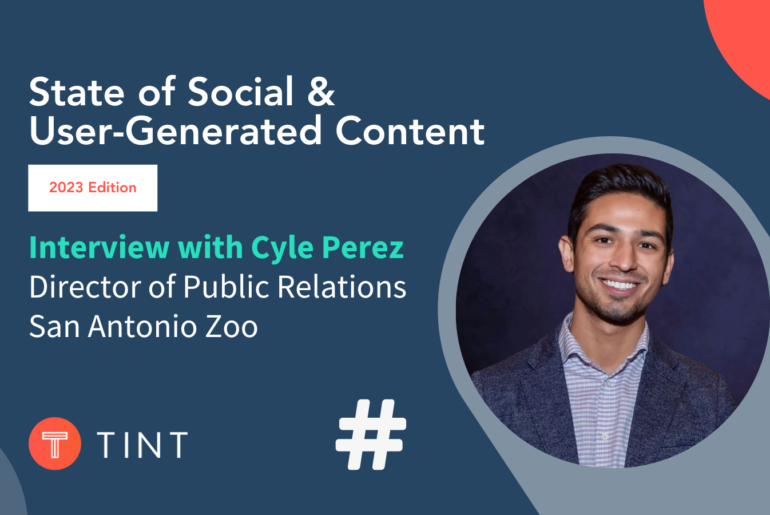There are many variants: Digital word of mouth, electronic word of mouth (eWOM), user-created content, and user-generated content (UGC). This inconsistency often raises questions about the proper term of art for marketing and communications professionals. TINT has always advocated for UGC as an umbrella term with dozens of “flavors” like constituent generated content and employee-generated content. We’re considering the research to find clarity in the language, specifically, are UGC and eWOM the same thing? Let’s get into UGC vs eWOM!
Academic Research
eWord-of-Mouth
Academia seems to be struggling with UGC vs eWOM too. A 2020 publication in the Journal of Marketing and Consumer Research is simply titled, “Is It Possible for ‘Electronic Word-of-Mouth’ and ‘User-Generated Content’ to be Used Interchangeably?”.
There seem to be two primary camps in academic circles. One believes that “UGC is a form of eWOM”. The other posits that “UGC is broader than eWOM”.
The use of Word-Of-Mouth, regarding marketing, is well established in marketing canon. One of the earliest recorded references was in a 1967 literature review by the Advertising Research Foundation. Early marketing texts start to develop the idea of “not commercial[ly] motivated” content (such as WOM) being a driver of action.
We don’t see a practical eWOM definition until 2004 when an article in the Journal of Interactive Marketing creates a framework for it. The researchers were to answer the question “what motivates consumers to articulate themselves on the internet?” They established four criteria for an eWOM statement.
Elements of eWOM:
- Positive or Negative Statement
- Made by Potential, Actual, or Former Customers
- Made about a Product, Service, or Company
- Made widely available to “multitude of people and institutions” through the internet
Subsequent efforts to define eWOM were variations on this framework. Some scholars rejected that statements must be positive or negative, allowing neutral commentary to be included in the consideration and thereby paving the way for what would become net promoter score criteria.
Others took issue with “potential customers” being included in the discussion, attempting to pull that piece of the conversation into the discipline of reputation management. Newer research has worked to add additional criteria like information exchange to make eWOM more dynamic and communicative in nature.
User-Generated Content
UGC also has an established and varied history. Perhaps the best historical perspective on UGC can be found in Axel Bruns’s simply titled “User-Generated Content” published in the 2016 International Encyclopedia of Communication Theory and Philosophy.
Bruns suggests that UGC first began with the “participative” internet. This was early communication platforms, beginning in 1990, with platforms like bullet board systems and internet relay chat. At this point, “user-created content” was also used to reference the multitude of pages, content, and code that was being created by early technologists. The new renaissance of UGC began a decade later when sites like Xanga, Geocities, and Friendster created new opportunities for the emerging digital natives and hobbyists to generate content.
Formalization of UGC as a term of art within marketing and communications seems to have started with the release of a 2006 Organization for Economic Corporation and Development (OECD) publication called “Digital Content Strategies and Policies”.
OECD UGC Definition
- Must be published and available online.
- Must be a creative effort using written and/or visual media.
- Must be created by a “user” outside of any professional capacity.
Additional scholarly discussion argues about the term “professional”. If a marketer creates a piece of UGC about an unrelated subject, is that no longer UGC because it was created by a professional?
There are also questions about Influencer Marketing and incentivization of content. Many UGC definitions require that content is created without “expectation of remuneration or profit”. If a business hosts a contest or promotion to drive content creation or acquisition, is that content still UGC?
Many scholars have firmly drawn a line in the sand that it is the creative effort and content created by an “end-user” that defines UGC. Incentives, promotions, or tactics used by marketers to acquire content are simply tools for aggregation. They do not change the inherent nature of the content.
eWOM vs UGC
Both eWOM and UGC have long histories and uses in both practice and academia. They are both involved with the sharing of information, opinion, and perspective across digital media.
However, eWOM is more limited in scope. eWOM, by definition, is generally written content about specific commercial transactions or experiences. It is an information-driven perspective that requires that existing, or possible, transactional relationship to happen.
UGC does not require a direct commercial relationship to function. UGC can be created about a variety of topics, experiences, and places. This means that UGC can be created about both concrete and abstract concepts. A photo can be created about a meal or a holiday. A review can be written about a concert and a political movement. Video can be created about dramatical satire and satirical drama.
UGC also encompasses the ever-widening varieties of media. User Content can now be vlogs, micro-video, or AR/VR experiences; and as technology evolves the available media will evolve with it.
Search Trends
Academia feeds practice and vice-versa. We also reviewed search trends as a pulse-check on UGC vs eWOM. We looked at both abbreviations and spelled-out terms to ensure a higher degree of accuracy. We’ve limited search trends to the United States to account for other popular uses of UGC abroad.
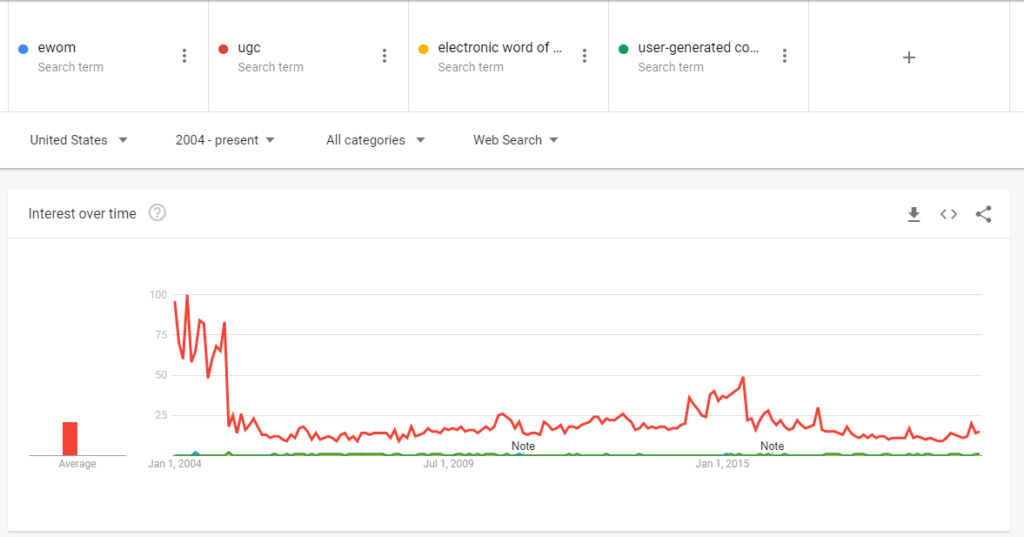
Considering UGC vs eWOM, UGC has a higher prevalence in search terms throughout the United States. eWOM as an abbreviation in incredibly weak with the full user-generated content search term having the occasional spike in popularity.
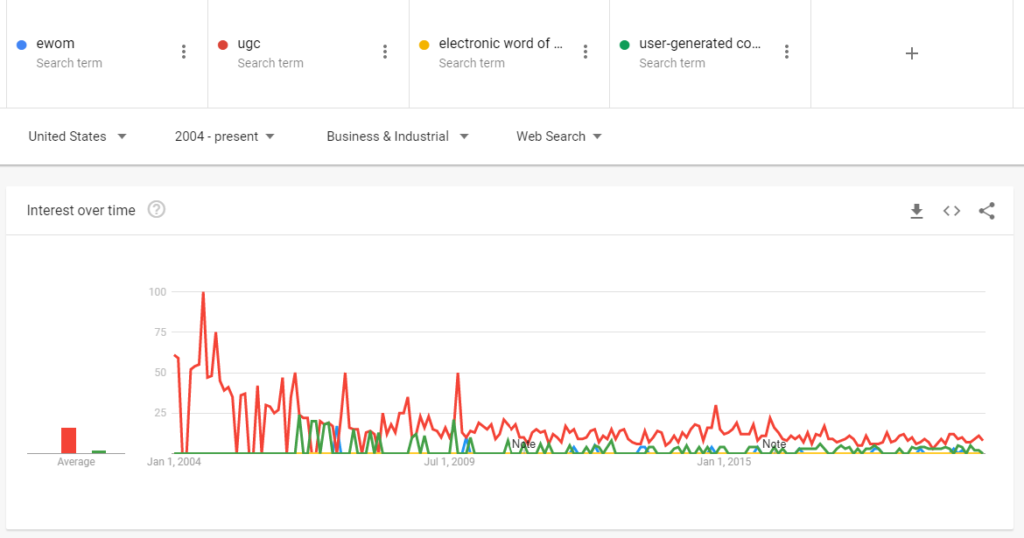
Focusing on Business and Industrial as a topic increases the trend interest over time. eWOM is virtually nonexistent. UGC continues to own the trend with only occasional spikes of user-generated content to momentarily leapfrog its popularity.
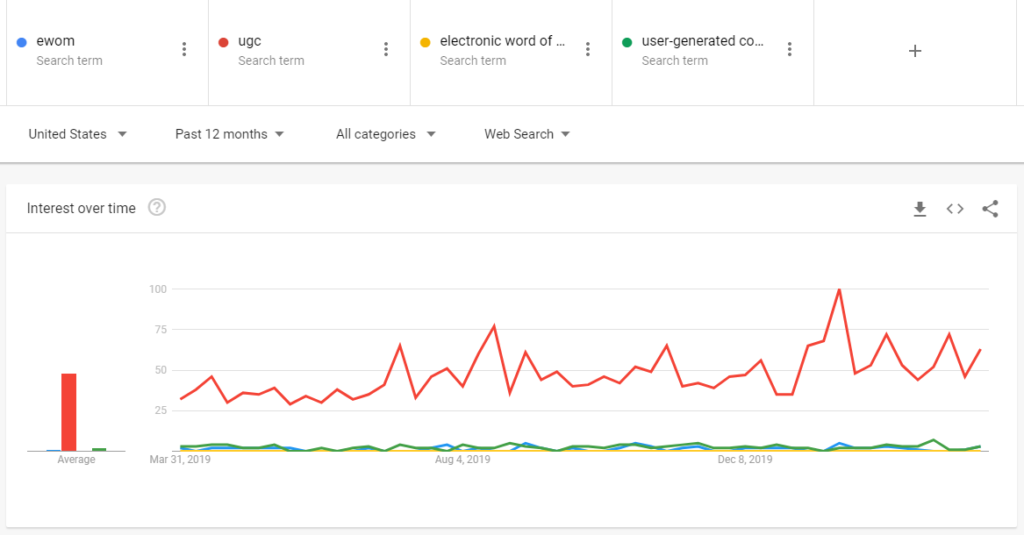
Looking at more recent trends, UGC is a significant force in the trendlines.
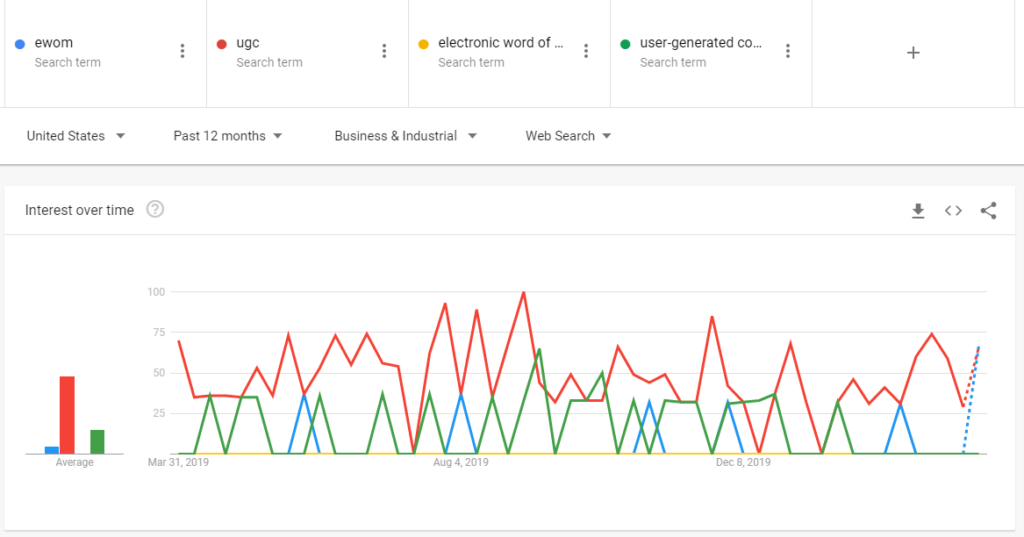
Again limiting the trends to Business and Industrial starts to see more spikes in variability. It is only recently that eWOM even starts to register as a competitive trend against UGC. This could be due to the increased usage in both academia and practice. Either way, UGC still holds strong as the common phrase for this particular use.
Whatever side of the UGC vs eWOM conversation you prefer, TINT creates tools that support the world’s top brands as they engage with the content created by their customers. Discover the power of TINT and chat with one of our UGC (or are they eWOM?) specialists today.



